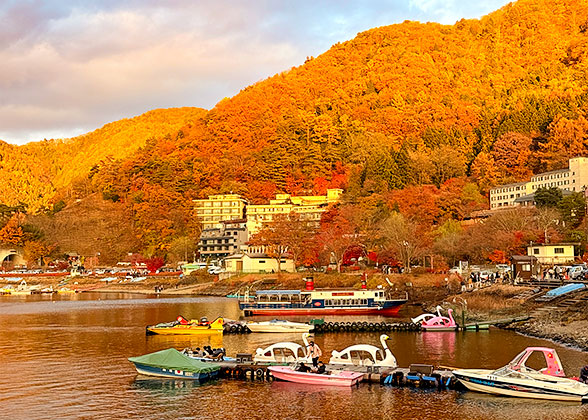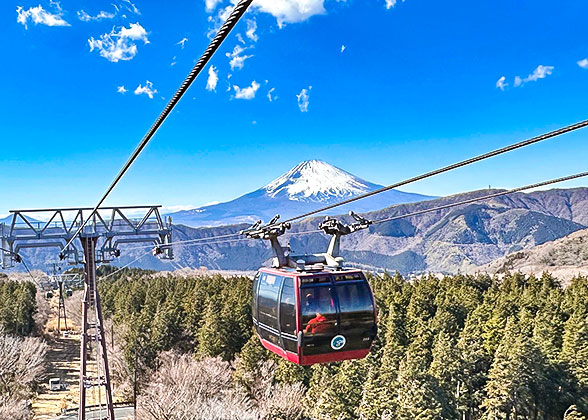Mount Fuji Weather
Mount Fuji has an altitude of 3,776 meters (12,388 feet), which creates distinct climate between its summit and the foothill. The summit experiences an alpine and tundra climate, characterized by cold and windy weather year-round, with snow remaining till early June from early October or early November in the previous year. The mountain foot has a temperate maritime climate with four distinct seasons: spring sees the snow melting and gradually rising temperatures; summer is hot and very humid; autumn gradually cools down; and winter is cold but the visibility is the highest of the year.
Temperature

Sunset Glow in Mount Fuji
|
 What is the hottest month in Mount Fuji?
What is the hottest month in Mount Fuji?
August is the hottest month in Mount Fuji, but there is no scorching heat. This month, the average temperature at the foot of the mountain is 18-28°C (64.4-82.4℉), with the highest temperature of only around 30°C (86℉). The summit, however, is cold even during this period: the temperature averages between 4-10°C (39.2-50℉), with the highest temperature seldom exceeding 12°C (53.6℉).
 What is the coldest month in Mount Fuji?
What is the coldest month in Mount Fuji?
January is the coldest month in Mount Fuji. The low temperatures in the foothills are basically below 0℃ (32℉) throughout the month, and the high temperature is only around 5°C on average, reaching 8℃ (46.4℉) occasionally. The top of the mountain is already covered with thick snow and is closed to climbers.
Precipitation & Humidity
Mount Fuji weather is humid and rainy. The annual precipitation at the mountain foot is 2,272mm on average, with the least precipitation in winter and the most precipitation in summer. There is more precipitation up on the mountain. Besides, the top of the mountain is more prone to snowfall due to its high altitude and low temperature.What months does Mount Fuji have snow?
Mount Fuji summit is covered with snow for about 7-8 months in a year. The first snowfall usually appears in October or early November, which varies based on the actual temperature. The snow cap usually forms in December. By April of the following year, the snow-covered area expands to its maximum and the snow is the thickest. The snow begins to melt slowly in May and disappears around mid-June.
Mount Fuji Weather by Month
What Is the Best Time to Go to Mount Fuji?
The best time to enjoy the snow-capped scenery of Mount Fuji is from December to February in winter when the visibility is the highest of the year.The opening period for climbing Mount Fuji is from early July to early September when the temperature on the mountain basically remains above freezing point. In particular, the period from the late July to late August marks the peak season for climbing Mount Fuji.
Read more about Best Time to Visit Japan & Japan Weather
Mount Fuji Weather by Seasons & Travel Guide
Spring: March to May
Mount Fuji weather in spring is becoming warmer and warmer, with the maximum temperature ranging from 11-21℃ (51.8-69.8℉) on average at mountain foot. However, the temperature drops quickly after sunset when it is generally below 10℃. In March, there are still several days with temperatures remaining below 0℃, so you can see that snow has not melted completely in some areas at the mountain foot.
The 5th Station of Mount Fuji, the highest elevation open to tourists in spring, is cold overall when the temperature at midday ranges between 1-11℃ (33.8-51.8℉), and from -12℃ to -1℃ (10.4-30.2℉) in early morning and at night.
Precipitation is commonly seen in the surrounding area of the Mount Fuji, where there are approximately 16-17 wet days every month.
In March, you are recommended to wear a long sleeved-shirt plus a fleece-line hoodie or a wool sweater inside, and a 3-in-1 jacket outside; as for the bottom, it’s safe to add a pair of long johns beneath your thick sweatpants. In April and May, you can wear a shirt and a cardigan together with casual pants most time; but you’d better bring a thermal outwear in case the temperature drops down when the sun is absent. As for the shoes, prepare a thick pair like the hiking boots for cooler days and a thin pair like the canvas shoes for warmer days. If you want to visit the 5th Station, you’d better wear warmly as you do in March, and make sure your shoes are suitable for walking on the slope.
In March and April, there is still a lot of thick snow on the top of the Mount Fuji. In May, the snow cap gradually shrinks. Anyway, you can see the snow-capped scenery of the Mount Fuji in spring as long as the weather is fine.
Early to mid-April is the best time to view cherry blossoms around Mount Fuji, which are in full bloom in places like the Lake Kawaguchi, Arakurayama Sengen Park, and Oshino Hakkai. Wear a mask if you have a sensitive nose to pollen.

Colorful Lake Kawaguchi in Spring
|
Summer: June to August
At the mountain foot, the weather gradually turns from warm to hot but not severe in summer months: the daytime temperature is generally above 20℃ (68℉), but rarely exceeds 35℃ (95℉). At the top of the mountain, it’s still cold although the temperature rises to a bearable range from 0-10℃ (32-50℉) mostly; the snow and ice has completely melted in July and August and the hiking trails are open accordingly. Rainy weather is quite often throughout the whole summer, especially in the rainy season from early June to late July when the monthly average rainy days are no less than 20.
Around the foothills of the mountain, a summer shirt together with thin pants or short trousers are suitable in sunny days. If it is overcast or rainy, accompanied by winds, it’s better to add a thin coat outside. Casual sneakers are comfortable for walking.
As for mountain climbers, you are advised to wear warmer clothes like the 3-in-1 jacket and wind-proof pants. Climbing boots and googles are essential for you.
The climbing season of Mount Fuji is from early July to early September each year. The number of mountain climbers reach the peak during the Obon Festival in mid-August. If you are a mountain climbing enthusiast, you’d better check the weather forecast in time for the mountaineering routes will be closed due to heavy rain or strong winds.
Every year in early August, the Lake Kawaguchi Festival is held, and you can see grand fireworks lighting up the night sky. Besides, you can enjoy activities such as canoeing and wakeboarding on the Lake Yamanaka near the Mount Fuji.

Mount Fuji in Summer
|
Autumn: September to November
It’s getting cooler and cooler in autumn at the foot of the mountain. The daytime temperature in September is around 15-25℃ (59-77℉), and by November it may drop to around 5-15 (41-59℉). After early September, the hiking trails to the top of the mountain are closed due to the dropping temperature, and the highest elevation you can visit remains the 5th Station.
Precipitation is large and frequent in early and mid-autumn. Then, it decreases both in quantity and frequency in November.

Stunning Autumn Scenery in Mount Fuji
|
In September to early October, you can wear summer clothes like a T-shirt with thin trousers, and prepare a thin coat for the cooler hours. If you are going to visit Mount Fuji in mid or late October, be sure to prepare layers like the long-sleeved shirt, thin hoodie, cardigan to cope with the temperature fluctuations. In November, the temperature drops further, so you’d better wear warmer outwear like the trench coat or the jacket with linings together with sweatpants. Canvas shoes are suitable for early autumn and thicker ones like the walking shoes are enough for mid and late autumn. As for tourists who want to visit the 5th Station, it’s better to wear thermal underwear plus wind-proof outwear to keep warm and comfortable warm shoes with anti-slip characteristics.
Late October to late November is the best time to enjoy the autumn leaves around Mt. Fuji, when maple trees in places like the shores of Lake Kawaguchi display their charming red and orange colors.
After late October, you can see elegant white swans wintering near the Lake Yamanaka.
|
|
|
Winter: December to February
In winter, the climate is cold even at the foot of the mountain. During the day, the temperature is generally below 10℃, but it turns freezing cold in the evening. Precipitation is mainly in form of light rain and snowfall. Due to climate change, the first snowfall may occur earlier in mid-autumn or later in early December.
Wool sweater plus fur-lined coat together with thermal sweatpants are suitable to keep warm. Besides, you are advised to wear a winter hat and scarf for extra warmth. As for the shoes, snow boots are optimal.
The visibility is the highest in winter, so the probability of seeing the whole view of Mount Fuji is also the greatest.
Except for watching the snow-capped Mount Fuji, there are more interesting winter activities you can add into your 2025 Mount Fuji trip. Every winter, there are light exhibitions in the Lake Kawaguchi and Lake Yamanaka. You can also enjoy winter fireworks in the Oike Park. Furthermore, the Snow Festival is held in the Saiko Wild Bird Forest Park from late January to February, when you can admire beautiful frost-covered trees. As a reminder, you’d better be careful of the slippery icy roads.
Under normal circumstances, visitors can go up to the 5th station, but if the weather conditions are bad and the ground is covered with snow and ice, the road will be closed.

Creamier Mount Fuji Summit
|





